#esp32 wrover
Explore tagged Tumblr posts
Text
youtube
Nappy Pins in Action ESP32 WROVER-E Blink Arduino early stage diy balsa wood nappy pins esp32 breakboard arduino blink test gpio2
0 notes
Text

ESP32 WROVER Kit, Compatible with Arduino IDE The starter kit is based on the development board from esp32 wrover. It integrates with bluetooth and wireless.A powerful dev board for IOT module project development.ESP32-WROVER series is developed by Espressif Systems, below is key features and applications are summarized: I. ESP32 Wrover Specifications - Chip Architecture - Dual-core SoC (ESP32-D0WD or D0WD-V3) with a clock speed of 80–240 MHz (dynamic frequency scaling)13 - 520 KB integrated SRAM, expandable via external SPI RAM/Flash1 - Built-in 4–16 MB SPI Flash and 8 MB SPI PSRAM (depending on model, e.g., WROVER-B/E)37 - Wireless Connectivity - 2.4 GHz Wi-Fi (802.11 b/g/n) with up to 150 Mbps throughput36 - Dual-mode Bluetooth: Classic (BT) and Low Energy (BLE)36 - Peripherals & Interfaces - SPI, I2C, UART, SDIO, Ethernet interfaces3 - Support for capacitive touch, Hall effect sensors, PWM outputs37 II. ESP32 Wrover Kit Development Environment & Tools - Programming Frameworks - Official ESP-IDF framework (FreeRTOS + LwIP stack), C/C++-based16 - Arduino IDE compatibility via ESP32 board manager28 - Optional Python/C hybrid development using Zerynth Studio5 - Hardware Debugging Tips - Use 5V power for camera modules (3.3V may cause image instability)2 - Adjust SPI pin definitions (e.g., SCK=14, MISO=12) based on hardware layout4 III. ESP32 Devkit Typical Applications - IoT Devices - Sensor networks, smart home controllers with ultra-low-power modes (sleep current Read the full article
0 notes
Photo

Buy Espressif ESP Wrover kit & development board online at affordable price from Campus Component a leading electronic component provider in India. The ESP-WROVER-KIT-VB is a variant of ESP-WROVER-KIT that comes with an ESP32-WROVER-B module by default. This board features support for an LCD and Micro SD card. The I/O pins have been broken out from the ESP32-WROVER-B for easy extension.
The board carries an advanced multi-protocol USB bridge (the FTDI FT2232HL), enabling developers to use JTAG directly to debug the ESP32 module through the USB interface. The development board makes secondary development easy and cost-effective. Module is FCC/ CE/ KCC/ IC/ TELEC/ SRRC/NCC certified. To know more about this product call on
+919767444555
or visit website
https://www.campuscomponent.com/products/espressif-esp-wrover-kit-vb-2-4-ghz-wifi-and-bt-ble-development-board/2208614000001841096
#Espressif ESP Wrover#esp32 wrover#esp32 development board#esp 32 datasheet#esp32 espressif#esp8266 wifi module#esp module
0 notes
Text
ESP32 low.js: Hello World
ESP32 low.js: Hello World

On this tutorial we will check how to create a simple “Hello World” application using low.js and the ESP32.
(more…)
View On WordPress
2 notes
·
View notes
Photo

ESP32 WROVER E with camera adapter for OV2640 lens Without SD-card slot but a huge count of available pins. #esp32 #esp32cam #wrover #microcontroller #maker #diy #tech #techy #technology #electronic #components #draegerit (at Stefan Draeger Software) https://www.instagram.com/p/CfmfphaLJqE/?igshid=NGJjMDIxMWI=
#esp32#esp32cam#wrover#microcontroller#maker#diy#tech#techy#technology#electronic#components#draegerit
0 notes
Text

ESP32 Starter and Development Kits for Building Bluetooth and WiFi Enabled IoT Devices
The ESP32-WROVER is a powerful small controller with an onboard camera, Wi-Fi and Bluetooth.
This kit helps you learn and use ESP32-WROVER with its components and tutorials.
https://copperhilltech.com/blog/esp32-starter-and-development-kits-for-building-bluetooth-and-wifi-enabled-iot-devices/
0 notes
Text
ESP-01 ESP32-WROVER-Bit WROOM-32U Wireless WiFi+Bluetooth dual-core CPU 25q16
ESP-01 ESP32-WROVER-Bit WROOM-32U Wireless WiFi+Bluetooth dual-core CPU 25q16

lastest_volume
0
Just For Today
Click Here To Visit The Shop
N€W ESP-01 ESP32-WROVER-Bit WROOM-32U Wireless WiFi+Bluetooth dual-core CPU 25q16
0 notes
Text
ESP32-WROVER-B/ESP32 WROVER-IB 2.4G WiFi Bluetooth module SPI wireless Espressif 4MB Flash ESP32-WROVER-B/ESP32-WROVER-IB
ESP32-WROVER-B/ESP32 WROVER-IB 2.4G WiFi Bluetooth module SPI wireless Espressif 4MB Flash ESP32-WROVER-B/ESP32-WROVER-IB

ESP32-WROVER-B/ESP32 WROVER-IB 2.4G WiFi Bluetooth module SPI wireless Espressif 4MB Flash ESP32-WROVER-B/ESP32-WROVER-IB
Price
5.57 Catch me HERE
0 notes
Text
ESP32-WROVER-B/ESP32 WROVER-IB 2.4G WiFi Bluetooth module SPI wireless Espressif 4MB Flash ESP32-WROVER-B/ESP32-WROVER-IB
ESP32-WROVER-B/ESP32 WROVER-IB 2.4G WiFi Bluetooth module SPI wireless Espressif 4MB Flash ESP32-WROVER-B/ESP32-WROVER-IB

lastest_volume
0
Just For Today
Click Here To Visit The Shop
N€W ESP32-WROVER-B/ESP32 WROVER-IB 2.4G WiFi Bluetooth module SPI wireless Espressif 4MB Flash ESP32-WROVER-B/ESP32-WROVER-IB
0 notes
Text
DSTIKE IPEX SMA antenna adapter ESP-07 ESP32 wrover
DSTIKE IPEX SMA antenna adapter ESP-07 ESP32 wrover

DSTIKE IPEX SMA antenna adapter ESP-07 ESP32 wrover
Price
1 Catch me HERE
0 notes
Text
LILYGO® TTGO T-Camera ESP32 WROVER & PSRAM Camera Module Data Cable
LILYGO® TTGO T-Camera ESP32 WROVER & PSRAM Camera Module Data Cable

LILYGO® TTGO T-Camera ESP32 WROVER & PSRAM Camera Module Data Cable
Price
1 Catch me HERE
0 notes
Text
Tree moisture meters
I had an interesting time last week attending the 4th Trees, People and the Built Environment (TPBE4) conference run by the Chartered Foresters. Some interesting sessions and worthy sentiments but I didnt get any sense of urgency.
A couple of the sessions addressed the use of technology in the urban forest. For example Nadina Galle talked about the Internet of Nature and the application of Smart City thinking, a city-wide network of sensors using AI to make better decisions about deployment of resources. GreenCityWatch have developed tools to create an inventory of urban trees using commercial high-resolution imagery and some open-source image analysis tools. Treemania aims to provide a network of moisture sensors to alert council staff to the need to water newly planted trees.
I have a love-hate relationship with these ideas. On the one hand they too often seem like expensive, irrelevant and authoritarian structures, all bright and shiny to lure unsuspected city councils desparate to show they are doing something towards the climate emergency. On the other hand, I’m a bit of a geek and love the idea of sensors to bring the life of trees to wider notice. Moisture sensors also fit well with a planned platform to assist citizens to look after new trees, in particular 590 trees being planted in deprived areas of Bristol, part-funded by the Urban Tree Challenge Fund.
Treemania’s sensor seemed from the pictures to use a common capacitive moisture sensor. I thought a remote sensor could be based on a board I’ve planned to use on the boat for remote sensing of water level and battery state. I’ve also been looking at it as a basis for a remote dendrometer. The board is an ESP32 with integrated GSM module, costing £15 or less. GSM (2G) is expected to continue to be supported in the UK through to 2025. Rui Santos has a great tutorial on using this board with Arduino code for just such a project. A capacitive soil moisture sensor costs a few quid, a temperature sensor likewise. The board has an integrated socket and charger for a 3.7v LiPo battery. In use the sensor will only need to report at a very low frequency - maybe only a few times a day, and with the ESP deep sleep mode the device should run unattended for a month or more. Soak testing is underway.
Acquiring a suitable SIM is challenging. Although mobile internet on a pay-monthly contract is down to £1 a Gb, minimum payment is around £10 a month. Given that only a Kb or so is used for a single HTTP GET to transmit the data, the device needs only a few Mbs a month. I found a couple of companies specialising in IoT connectivity. The cheapest is ThingsMobile, based in Milan and the cost is more like £10 per annum. Even here, the cost per Mb is 100s of times more expensive than your regular Pay monthly sim. It took ages to arrive but works fine and at E0.12 / Mb is pretty good.
So the bill of materials is:
TTGO T-Call ESP32 SIM800L board
Capacitive Moisture Sensor
DS18B20 Waterproof Digital sensor
3.7v LiPo
waterproof container
Overall cost for the components should be under £40.
Wiring is straightforward: The moisture meter needs 3.3v power and an A2D pin (ADC0) ; the thermometer is a one-wire interface needed a digital I/O pin (Pin25) with a 4K7 pull-up resistor. Rui also has a great tutorial on interfacing this sensor. I got stuck for a while on this, not realising which GPIO pins supported I/O. Accurate pin-out diagrams and the datasheet for the right variant of board are essential. A small auxiliary veroboard wired directly to the ESP32 board handles these connections. The ESP32 board is supplied with a simple aerial which worked fine. A better quality aerial costs a few quid.
This is the current lashup

Rough sketch of wiring: R is 4K7

The Arduino script hard-codes the GPRS parameters, the HTTP parameters to use GET to send the data to the server and the sleep interval. This code is on GitHub
Periodic readings are sent to my server where they are logged and graphed and from where alerts can be generated. A test harness only at present so nothing worth sharing yet.
Summary
The prototype is working. The moisture sensor needs good waterproofing and seems a bit sensitive to placement. The power draw of the GSM is quite high high during transmission. I’m also running a WiFi version and of course its power draw is much less. It would be nice if the Bristol LoRaWAN network was up and running but that seems to have gone very quiet.
The main problem is with power. This board includes a (very small) JST connector for a LiPo and a charger, For a while it switched happily from USB power to battery and back without manual intervention. LiPos are small and expensive however and I’m currenly experimenting with 18650 batteries which offer better storage/£ .
References
T-Call pinout
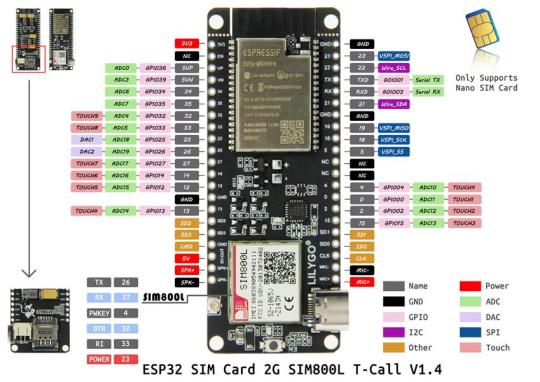
ESP32-WROVER datasheet
TTGO T-Call on GitHub
1 note
·
View note
Link
Buy Espressif ESP Wrover kit & development board online at affordable price from Campus Component a leading electronic component provider in India. The ESP-WROVER-KIT-VB is a variant of ESP-WROVER-KIT that comes with an ESP32-WROVER-B module by default. This board features support for an LCD and Micro SD card. The I/O pins have been broken out from the ESP32-WROVER-B for easy extension.
The board carries an advanced multi-protocol USB bridge (the FTDI FT2232HL), enabling developers to use JTAG directly to debug the ESP32 module through the USB interface. The development board makes secondary development easy and cost-effective. Module is FCC/ CE/ KCC/ IC/ TELEC/ SRRC/NCC certified. To know more about this product call on
+919767444555
or visit website
https://www.campuscomponent.com/products/espressif-esp-wrover-kit-vb-2-4-ghz-wifi-and-bt-ble-development-board/2208614000001841096
#Espressif ESP Wrover#esp32 wrover#esp32 development board#esp 32 datasheet#esp32 espressif#esp8266 wifi module#esp module
0 notes
Text
ESP32-CAM WROVER E
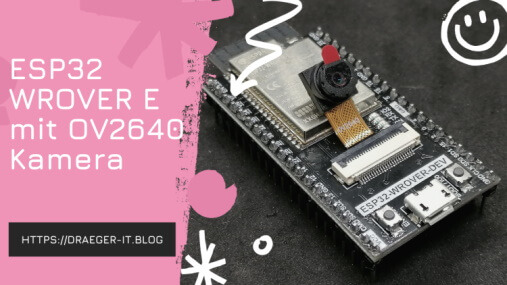
In diesem Beitrag möchte ich dir eine weitere ESP32-CAM vorstellen und zeigen, wie du diese programmierst.

Eine ESP32-CAM habe ich dir bereits im Beitrag Einrichten der ESP32-CAM und erster betrieb vorgestellt und auch gezeigt, wie du diese in der Arduino IDE programmierst.


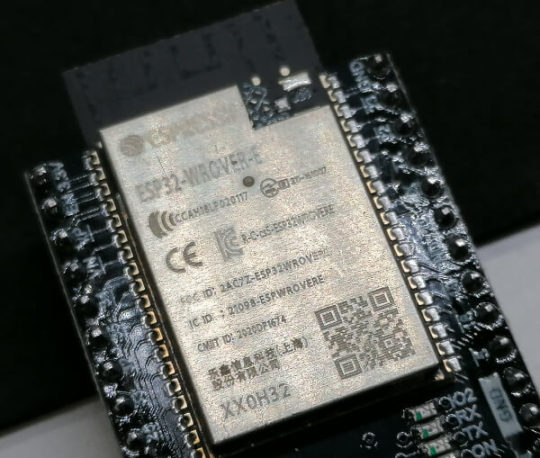
Bezug der ESP32-CAM WROVER DEV
Die mir vorliegende ESP32-CAM habe ich recht günstig über aliexpress.com für knapp 7 € zzgl. Versandkosten erstanden. Du findest die coole ESP32-CAM auch auf amazon.de für knapp 35 € als Set mit diversen Sensoren / Aktoren. Lieferumfang Zum Lieferumfang der ESP32-CAM gehört neben dem Mikrocontroller noch ein kleine 66° Kameralinse vom Typ OV2640.

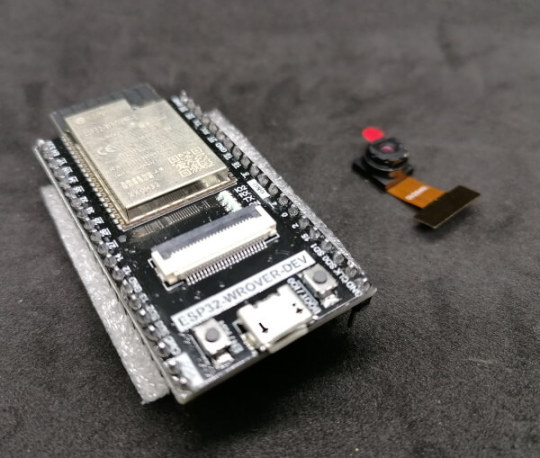
Anschluss der ESP32-CAM
Der Anschluss an den Computer erfolgt über eine Micro-USB Schnittstelle. In meinem Fall war kein passendes Kabel dabei (jedoch im verlinkten Amazon Produkt ist es enthalten). Im Geräte-Manager von Microsoft Windows 10 wird der Mikrocontroller als "USB-SERIAL CH340" angezeigt.

Geräte-Manager von Windows 10 mit angeschlossener ESP32-CAM Während des Betriebs der ESP32-CAM leuchtet eine kleine grüne SMD LED.
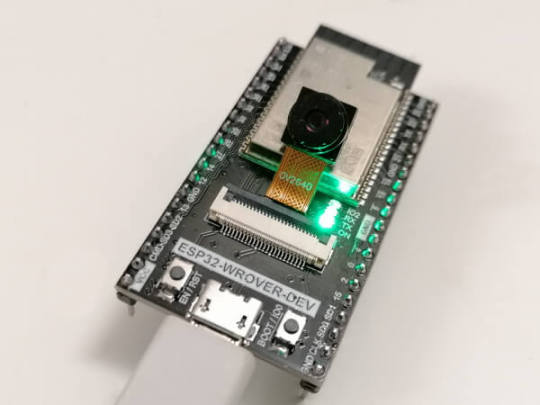
Technische Daten des ESP32 WROVER E
Hier nun ein kleiner Auszug aus den technischen Daten des ESP32 WROVER E. MicrochipESP32-D0WD-V3 Xtensa 32bit LX6Taktgeschwindigkeit240 MHzROM448 KBSRAM520 KBSRAM (in RTC)8 KBPSRAM8 MBSPI flash4 MBWiFiProtokolle - 802.11 b/g/n (802.11n bis zu 150 Mbps)Frequenzbereich - 2412 ~ 2484 MHzBluetoothProtokolle - Bluetooth v4.2 BR/EDR und Bluetooth LE (Low Energy)FeaturesUART, SPI, I²C, LED, PWM, Motor PWM, I²S, IR, Puls Counter, GPIO, kapazitiver Touch Sensor, ADC, DAC, TWAI (Two-Wire Automotive Interface), kompatibel mit ISO11898-1 (CAN-Bus Spezifikation 2.0)Hall SensorSpannungsaufnahme3.0 V ~ 3.6 VStromaufnahme500 mABetriebstemperatur-40 °C ~ 85 °C Im englischen Dokument ESP32WROVERE Datasheet findest du eine ausführliche Liste mit den technischen Daten zum ESP32 WROVER E.
Programmieren in der Arduino IDE
Das ESP32-CAM Beispiel aus der ESP32 Bibliothek beinhaltet eigentlich auch die Konfiguration für das vorliegende Modell, jedoch ist das Kompilat 10 % größer als der verfügbare Speicher des ESP32. text section exceeds available space in boardDer Sketch verwendet 1431461 Bytes (109%) des Programmspeicherplatzes. Das Maximum sind 1310720 Bytes. Globale Variablen verwenden 65344 Bytes (19%) des dynamischen Speichers, 262336 Bytes für lokale Variablen verbleiben. Das Maximum sind 327680 Bytes. Sketch too big; see https://support.arduino.cc/hc/en-us/articles/360013825179 for tips on reducing it. Fehler beim Kompilieren für das Board ESP32 Wrover Module. Auf der Seite https://freenove.com/fnk0060/ findest du eine ZIP-Datei mit allem, was du benötigst, um den ESP32 CAM vom Typ WROVER E zu programmieren und unter anderem ist dort auch eine komprimierte Version enthalten. Zum einen hat der vorliegende Mikrocontroller kein SD-Karten Slot und somit benötigen wir diese Konfiguration inkl. Bibliothek nicht.
Webinterface
Bevor du das Beispiel aus dem Ordner "Freenove_ESP32_WROVER_Board-mainCSketchesSketch_05.1_CameraWebServerSketch_05.1_CameraWebServer.ino" auf den ESP32 speicherst musst du lediglich die SSID & das Passwort von deinem WiFi Netzwerk eintragen. const char *ssid_Router = "********"; //input your wifi name const char *password_Router = "********"; //input your wifi passwords Während des Uploads musst, du, wenn die Ausgabe mit den vielen Punkten erscheint die Taste "EN/RST" betätigen und der Upload wird ausgeführt. Nachdem erfolgreichen Upload kannst du im seriellen Monitor der Arduino IDE die IP-Adresse des Mikrocontrollers ablesen. Über diese IP-Adresse kannst du das Webinterface erreichen und einen Stream deiner ESP32-CAM betrachten und auch Bilder speichern.

Webinterface der neuen ESP32-CAM von 2022
Vergleich mit dem Vorgängermodell
Wie bereits erwähnt habe ich dem Vorgängermodell bereits einige Beiträge gewidmet und auch gezeigt, wie du die Bilder / den Videostream per Python abgreifst und speichern kannst. Da das neue Modell sehr ähnlich funktioniert, kannst du die Beiträge auf den Mikrocontroller adaptieren.

ESP32-CAM Modelle Was zunächst auffällt ist, das die neue ESP32-CAM ohne SD-Card Slot und LED Blitz daherkommt, jedoch bietet diese deutlich mehr GPIO Pins und somit kann man diese recht einfach nachrüsten. Zusätzlich bietet die neue ESP32-CAM vom Typ WROVER E einen onboard FTDI Chip CH340 welcher durch die vorhandene Micro-USB Buchse ohne ein zusätzliches, externes FTDI Modul t die Programmierung ermöglicht. Beim Vorgängermodell wurde dieses mit einem speziellen Board gelöst, auf welches der Mikrocontroller gesteckt wurde.
Vergleich der technischen Daten
Hier ein kleiner Vergleich der technischen Daten der beiden Mikrocontroller. ESP32-CAMESP32 WROVER E CAMMicrochip32Bit Dual Core CPU ESP32-D0WD-V3 Xtensa 32bit LX6Taktgeschwindigkeit240 MHz240 MHzPSRAM4 MB8 MBSPI flash4 MB4 MBWiFi802.11 b/g/n/e/i802.11 b/g/n (802.11n bis zu 150 Mbps)BluetoothBluetooth v4.2 BR/EDR und Bluetooth LE (Low Energy)Bluetooth v4.2 BR/EDR und Bluetooth LE (Low Energy)FeaturesUART, SPI, PWM, GPIO, kapazitiver Touch Sensor, ADC & DACUART, SPI, I²C, LED, PWM, Motor PWM, I²S, IR, Puls Counter, GPIO, kapazitiver Touch Sensor, ADC, DAC, TWAI (Two-Wire Automotive Interface), kompatibel mit ISO11898-1 (CAN-Bus Spezifikation 2.0)Auszug aus den technischen Daten der ESP32-CAMs Read the full article
0 notes
Photo



MicroByte
#CrowdSupply What is MicroByte?MicroByte is a hand-held, open-source retro-console, which can execute games from NES, GameBoy, GameBoy Color, Game Gear, and Sega Master System. It owns a powerful battery life of up to 6/7 hours with a colorful, high pixel density 1.3" IPS screen.MicroByte is controlled by an ESP32-WROVER E microcontroller module. And it is fully compatible with Arduino IDE.It maybe the tiniest hand-held console you have ever seen -- The entire console measures just 78 x 17 x 40 mm (3.07 x 0.67 x 1.57 inches). It seems a great choice to bring it when you are going out.
-
-Learn more: http://bit.ly/3c8pyrB -
0 notes